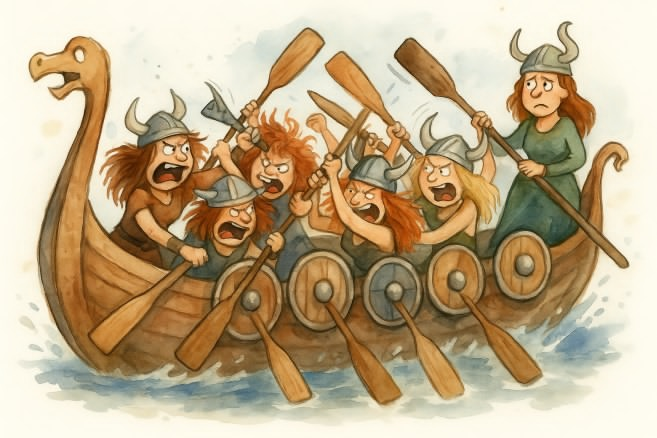Understanding the Difference Between Mono-Mind and Multi-Mind
Ever had that moment where one part of you is ready to leap into something new…
…but another part is shouting, “Absolutely not,”
…while a third part quietly slides away to eat Ben and Jerry’s under a weighted blanket?
Welcome to being human.
That’s not dysfunction. That’s not you being dramatic.
That’s just the truth of how our minds actually work.
And once you understand that, everything starts to make a lot more sense.
🌪️ The Myth of the “One True Self”
Most of us were raised with the idea that we should be one unified person—one voice, one opinion, one personality neatly packaged. That’s what psychologists sometimes call the mono-mind model.
But if you’ve ever argued with yourself, sabotaged your own best intentions, or been caught in a tangle of “part of me wants to, but another part doesn’t…”—you know that’s just not how things roll.
The truth is, we’re not made up of just one voice.
We’re more like a small village—or a crew of rowdy travellers on the same ship.
🧩 You’ve Got Parts—And That’s Not a Problem
The idea of a multi-mind says that you have different “parts” within you.
Some are bold. Some are anxious. Some want to take the leap. Some want to keep you safe and wrapped in bubble wrap forever.
These parts aren’t bad.
They’re not broken.
They’re just trying to help in the only ways they know how.
Most of these parts were formed during moments of stress, trauma, or confusion—times when your nervous system needed support and didn’t quite know where to find it.
They stepped in to help you survive. And many of them are still doing the same job, even if you’ve long outgrown the need.
🚣🏽♀️ Picture This: Your Brain as a Viking Ship
One of my favourite metaphors for this is the Viking ship.

You, at your best, are the captain—steady at the helm, eyes on the horizon.
But down below? You’ve got a whole crew of paddlers.
Some are rowing in sync. Some are rowing backwards.
One’s got a hangover. Another is screaming into the wind because she’s still stuck in something that happened at age 7.
And two are arguing over whether you should just turn around and sail back to your comfort zone.
This is normal.
If no one’s steering, the ship goes in circles—or straight into the rocks.
But when the captain (your calm, grounded Self) starts listening to the crew, things shift.
Not instantly. Not perfectly. But enough to start heading in the right direction—together.
🧘🏽♀️ So Who’s the Captain?
Inside all of us is a part that isn’t overwhelmed or reactive.
It’s not scared or angry. It doesn’t need to prove anything.
It’s steady. It doesn’t Judge it watches with compassionate curiosity.
That’s what we call the Self.
It’s the part of you that can gently hold the reins when things get wild. It doesn’t push the parts away. It listens, leads, and creates enough safety for real change to happen.
Problem is…the more historical trauma the deeper that Self is buried. Like a beautiful exquisite crystal hidden in a rubber band ball of traumas. To get to the good stuff you have to one by one work through the limiting beliefs picked up by parts that haven’t clocked you are no longer a 5 year old kid.
🧬 Where This Wisdom Comes From
While parts work has become more popular recently through therapeutic models like Internal Family Systems (IFS) and Hakomi Therapy, the idea itself is ancient.
In many traditional cultures, especially within indigenous and shamanic healing traditions, it was understood that people could lose parts of their soul or carry fragmented energies after trauma. This concept is often referred to as soul loss, and the healing practice of soul retrieval is still alive in many communities today. If you’re curious, the work of Michael Harner is a good place to explore this further.
Modern parts work brings that old wisdom into present-day therapeutic language.
Ron Kurtz, who developed Hakomi Therapy, focused on the felt experience of the body. In Hakomi, parts often show up not as abstract ideas, but as gestures, postures, sensations, or images that emerge during quiet, mindful moments.
Dr. Richard Schwartz, who created Internal Family Systems (IFS), offered a more structured map—naming the different kinds of parts (like Protectors and Exiles), and introducing the concept of Self as the healing leader within.
Ron and Richard were friends. They spoke often about their methods and respected one another’s work. Both saw clearly: we are made up of many parts, and healing begins when we stop fighting them—and start listening instead.
💡 Why This Matters
When you understand that your inner world is more like a community than a courtroom, everything changes.
You can:
-
Notice what’s happening without judgment
-
Pause before reacting
-
Understand your patterns with compassion
-
Lead yourself from your centre—not your chaos
You don’t need to get rid of your parts.
You don’t need to battle them into submission.
You just need to help them trust that there’s a wise captain on deck.
🫶 Final Thoughts From the Helm
You’re not broken.
You’re not too much.
You’re not a failure for having mixed feelings or messy thoughts.
You’re a human with a whole crew inside—each one doing their best with the tools they were given.
And when you start steering from your Self, rather than the loudest voice on board?
That’s when the journey really begins.

Curious about what your inner crew might want you to hear?
That’s the work I love most. Let’s explore it together.
👉 Book a free discovery chat and we’ll see what direction your ship is ready to sail in.
0 comments on “You’re Not Just One You — And That’s Totally Normal”Add yours →